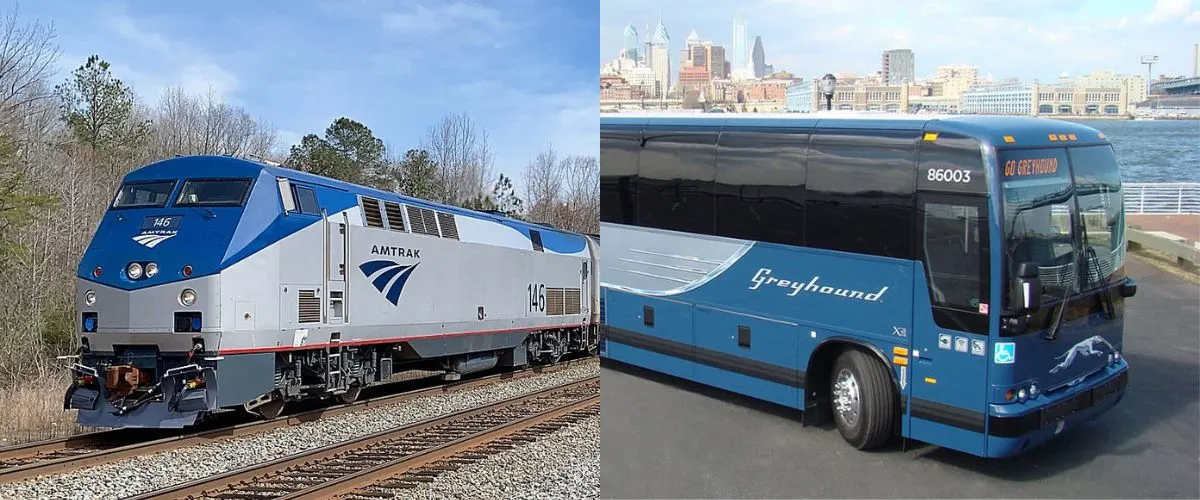
Amtrak vs Greyhound – Which is Better?
When planning a trip across the United States, many people wonder about the difference between Amtrak vs Greyhound. Both offer ways to travel between cities, but they are very different experiences. Amtrak is a train service known for being more comfortable with bigger seats and smoother rides. Greyhound is a bus service that is usually cheaper and can go to more places. In this blog, we will compare these travel options to help you decide which one is better for your next trip, focusing on price, comfort, travel time, and convenience.
Key Differences Between Amtrak and Greyhound
When choosing between Amtrak and Greyhound, it’s important to understand the key differences in price, comfort, speed, coverage, and overall travel experience to make the best choice for your trip.
| Factors | Amtrak | Greyhound |
|---|---|---|
| Price | Generally higher, but competitive on longer routes. | Usually cheaper, especially for short to medium distances. |
| Comfort | More spacious seating, smoother ride, restroom, and food service on board. | Less legroom, bumpier ride, single restroom, fewer amenities. |
| Travel Speed | Trains run 110-145 mph, but can face delays due to freight trains. | Buses travel at about 70 mph, affected by traffic and weather. |
| Reliability & Delays | Subject to freight train priority delays, but with less weather impact. | Susceptible to traffic jams, accidents, and weather conditions. |
| Network Coverage | Operates in 46 of 48 continental states, with fewer stations per state. | Operates in 34 states, but has more stations per state. |
| Safety | Generally safer due to rail travel, fewer accidents. | More prone to accidents due to road conditions and traffic. |
| Boarding & Accessibility | Easy boarding, accessible stations, and facilities. | Also, easy boarding, but variable station quality. |
| Travel Experience | More relaxing, quieter, better amenities. | More utilitarian, fewer amenities and comfort. |
Pros and Cons of Amtrak vs Greyhound
Choosing between Amtrak and Greyhound can be tricky, but knowing the key differences in cost, comfort, travel time, and service can help you pick the best option for your trip.
| Service | Pros | Cons |
|---|---|---|
| Amtrak | More comfortable seating and a smoother ride | Generally more expensive than Greyhound |
| Onboard restrooms and food service | Can face delays due to freight train priority | |
| Safer mode of travel | Limited station locations compared to Greyhound | |
| Active rewards program for frequent travelers | ||
| Greyhound | Usually cheaper fares | Less comfortable seating and bumpier rides |
| More station stops, serving more cities | Prone to traffic delays and weather impacts | |
| Greater route frequency in some areas | Fewer amenities and basic onboard facilities | |
| Passenger experience can vary widely |
Which is best for you Amtrak or Greyhound?
Understanding when to choose Amtrak or Greyhound can help you make smarter travel decisions based on your budget, schedule, and comfort needs.
| Choose Amtrak If | Choose Greyhound If |
|---|---|
| Prioritize comfort with spacious seating and smoother rides | When you are traveling on a tight budget and need the most affordable fare |
| When you want onboard amenities like restrooms and food service | If you need more frequent routes and more stops in smaller towns |
| Safety and reliability are important, especially with less impact from the weather | When flexible travel options and a wide station network matter |
| You want to earn rewards through a loyalty program | If you are willing to trade comfort for cost savings |
| When you prefer a quieter and more relaxing travel experience | When your destination isn’t accessible by train services |
Note: Both Amtrak and Greyhound offer unique advantages depending on your travel needs. By understanding the differences in price, comfort, speed, and coverage, you can choose the best option that fits your priorities and makes your journey enjoyable and hassle-free.
Frequently Asked Questions
Greyhound is generally cheaper, especially for short to medium distances. Amtrak tends to be more expensive but can be competitive on longer routes.
Amtrak offers more spacious seating, smoother rides, onboard restrooms, and food service, making it a more comfortable option compared to Greyhound buses.
Trains can run at speeds of 110-145 mph, but may face delays from freight trains. Greyhound buses travel around 70 mph and can be affected by traffic and weather. Travel times vary depending on routes.
Amtrak operates in 46 of 48 continental states, but with fewer stations per state. Greyhound operates in 34 states but typically has more stations per state, offering greater stop frequency.
Amtrak is generally considered safer due to rail travel having fewer accidents compared to road travel, while Greyhound faces risks from traffic and road conditions.

